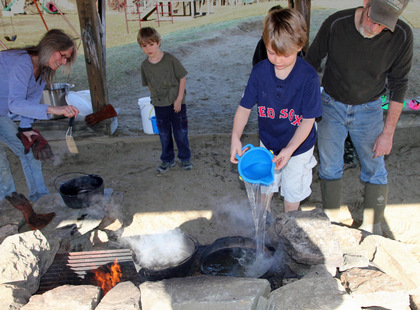
Warren kindergarten teacher Roni Donnenfeld helps her students
boil their sap into syrup in kettles over a wood fire. Photo: Andreas Lehner
The early arrival of warm temperatures followed by the return of snow and freezing nights put an end to maple sugaring season for most local producers. Without the cooperation of the weather the sugaring season was cut short leaving the sugarmakers with a fraction of the usual yield, compared to previous years.
It takes approximately 40 gallons of sap to produce one gallon of syrup. The normal maple season lasts about four to six weeks, starting as early as February.
Last year, the sugaring season arrived late and went well into April. This year’s early arrival of warm weather had many local sugaring operations unprepared for the season.
Avery Long, who sugars in Fayston, said his production was down by about half this year. He said that trees are already budding and that even if the sap ran again, it would be bitter. Such bitter sap, he said, can be collected and is sold to canners who use it for maple flavoring but not sweetness.
Long has a vacuum operation and also added some more taps this year but said he was only able to boil on a few days.
Another Fayston sugarmaker, Pat Livingston, took the year off from sugaring and said, “I picked the right year.”
“With the way the weather was and the price of fuel and the fact that I still had a fair amount of syrup leftover from last year, I decided to take a break,” he said.
Livingston usually taps about 1,000 trees and makes about 150 gallons of syrup.
At the Warren Elementary School, kindergarten teacher Roni Donnenfeld taps three to seven trees with her students and this year they gathered 13 gallons of sap and boiled it down to about a pint of syrup which students enjoyed with snow and pickles. Normally Donnenfeld and her students gather about 40 gallons of sap which they boil down in kettles over a wood fire on the school playground.
Waitsfield sugarmaker David Clark said his season was pretty successful in part due to a new vacuum system that he credits 80 percent of his production to.
“I made medium amber syrup and one dark, about two-thirds of what I normally make,” Clark said.
The key, Clark said, is to be ready early. “It was an early quick season. If I’d been ready in January I could have got some sap. The weather just wasn’t right for it most of the time,” he said.
In total Clark made 40 gallons of syrup that he sells at The Drug Store in Waitsfield and from home.
Chris Mayone is a backyard sugarmaker from Fayston. He said that this season was a borderline disaster. Now in his fourth year of sugaring, he said he barely made enough syrup to justify the work of putting out the taps and buckets.
“My production was down 80 percent from last year. I made five gallons as opposed to an expected 25 gallons. I began the season two weeks earlier than last year and it ended three weeks earlier than last year. It never ran normally for me at all,” he said.
Mayone, who sugars with the help of his two young children Jasper and Stella, was helped by his wife Kaiya Korb this year as well, due to a knee injury.
“The sap ran in dribs and drabs. I did not find the quality of the sap to be much different during the early part of the run, but in the last two weeks the sap has been terrible. I was lucky to make the final two gallons I did,” he said.
He taps about 35 trees with 52 taps and normally collects 500 to 600 gallons of sap. This year he collected 135 gallons in three weeks. While he collects the sap in buckets, he has an evaporator and sugarhouse for the boiling.
Easty Long’s Fayston sugaring operation ended on March 21 after he said, “It got so hot that we couldn’t do anything with the sap.”
Long said this year’s crop was half what it was the year before; “The season wasn’t good. The first day we boiled was the last day of February, and sugared off until March 21. It’s like that all over the state,” he said.
While the season may have come to an early close, Long said he’s not sure if he’s totally done given the recent below-freezing nights, cold days and snow.
“It was 11 degrees here last night. I’m not sure if the sap will run anymore, but we’ll see when it warms up. I haven’t pulled any spouts,” Long said.
Last year Long said he went “quite a ways into April, but it was an unusually late season. This year it was extremely early.”
Despite the weather, Long said he “made good grade” and produced 2,000 gallons of syrup.
Vermont is the largest producer of maple syrup in the United States, producing 40 percent of the total U.S. crop in 2011. Every county in Vermont produces some maple syrup and it is estimated that we have around 2,000 maple producers in the state. In 2011, those producers made an estimated 1,140,000 gallons of maple syrup.
Vermont also has a strictly enforced maple grading law controlling standards of density, flavor and color. The grade of maple syrup must be plainly and correctly marked on each container, along with the name and address of the producer.
Troy Kingsbury hosted the annual maple syrup taste-off competition at the Village Grocery in Waitsfield last week. Mike Quenneville of Fayston won for the second year in a row.
{loadnavigation}





